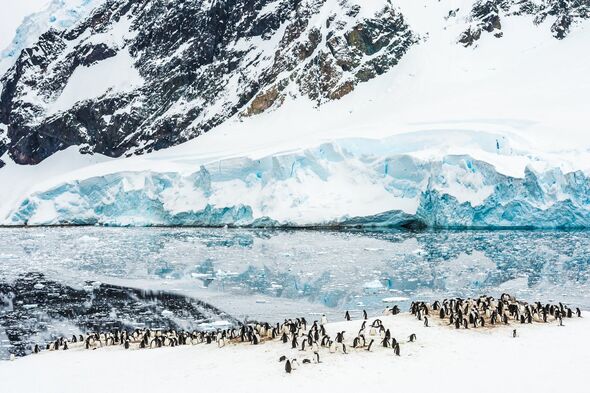It might surprise you to learn that only six of the world's 17 penguin species live permanently in the Antarctic region, and of those, only four breed on or near the Antarctic continent itself: Adélie, chinstrap, gentoo and emperor penguins. As well as the 'true' Antarctic species, there are also several other types of penguin that you are likely to see on your way to and from the Peninsula, most of which live on sub-Antarctic islands such as South Georgia.

Image Credit: ©Silversea Cruises Ltd.
Here is our guide to the penguins you can expect to see on your Antarctica cruise:
Emperor penguins
The emperor penguin is the largest of all the penguin species, standing over a metre tall. They are also the most southerly species, and consequently one of the most difficult to see on an expedition cruise. Emperors spend the harsh Antarctic winter huddled together on the open ice, and their breeding season runs from April to December. You'll need to travel to the Ross or Weddell Sea to find emperor penguins, and cruises to these regions are quite rare. Quark Expeditions occasionally operate itineraries visiting the emperor penguin colony off Snow Hill Island, as does Ponant's amazing hybrid-powered luxury icebreaker, Le Commandant Charcot.

Adélie penguins
The little Adélie penguin is the species you will see the most of on an Antarctica cruise, recognisable by their tuxedo-like plumage and comical way of waddling across the ice. Breeding season for Adélies runs from November to February, and they live across the Antarctic continent and nearby islands. The species is named after the Antarctic territory of Adélie Land, which was itself named after Adèle Dumont d'Urville, the wife of a famous French explorer. This name may sound familiar if you're a fan of French cruise line Ponant, since they are naming one of their new expedition yachts Le Dumont d'Urville.

Image Credit: ©Silversea Cruises Ltd.
Chinstrap penguins
Chinstrap penguins take their name from their distinctive plumage, and are particularly aggressive, sometimes known as 'stonebreaker penguins' on account of their piercing screech. Chinstraps are found on the Antarctic Peninsula and on islands including the Falklands and South Georgia, so they're a common sight on Antarctic cruise itineraries, and their breeding season runs between December and March.

Macaroni penguins
Macaroni penguins are easy to spot thanks to their distinctive yellow crests, and they are found on both the Antarctic Peninsula and sub-Antarctic islands, especially on South Georgia and Heard Island. There are around 9 million breeding pairs of macaronis in the wild, making them the most numerous penguin species in Antarctica, and, like most other types of penguin, they congregate in huge colonies. You can also spot macaroni penguins by the way they move over land - they are hoppers, rather than waddlers.

King penguins
King penguins are the second largest penguin species, and they live on the sub-Antarctic islands that surround the continent. The biggest colony is on South Georgia, with over 100,000 breeding pairs, an astonishing sight that is well worth the extra effort and expense of reaching this remote island. King penguins are perhaps the most instantly recognisable species, with their yellow neck feathers, though their fluffy chicks look so different that they were once thought to be a separate species. King penguins have a complex breeding system, with an early and a late season, and each pair will raise two chicks every three years.

Gentoo penguins
Gentoo penguins are closely related to Adélie and chinstrap penguins, but can be identified by the white stripe over their eyes. Gentoos are the fastest swimmers of all the penguin species, reaching top speeds of up to 36km per hour, and they are also coping better with climate change compared to other species, with their numbers and distribution actually on the rise. Gentoos can be found on both the Antarctic Peninsula and islands including the Falklands and South Georgia, so you're sure to meet them on an Antarctica cruise.

Rockhopper penguins
Rockhoppers look similar to macaroni penguins, with their spectacular yellow crest, but they are not a true Antarctic species, since you will only find them on sub-Antarctic islands and the South American mainland. Rockhoppers are one of the smaller penguin species, and, as their name suggests, they get around on land by hopping rather than waddling. They are also one of the world's most populous species, and top places to see them include the Falkland Islands and the coasts of Patagonia.

Image Credit: ©Silversea Cruises Ltd.
Other places to see penguins
Although rare, you will sometimes find expedition cruise itineraries visiting New Zealand's sub-Antarctic islands, home to at least five species of penguin, including erect-crested, yellow-eyed and Fiordland penguins. Ponant are one of the few operators who visit these islands, with a couple of voyages coming up in 2020.

All penguin species live in the Southern Hemisphere, with the exception of the Galapagos penguin, which can survive close to the Equator thanks to the cool temperatures of the Humboldt Current. Penguins are just one of the many unique and unusual bird species you can see on a Galapagos cruise, along with blue-footed boobies, frigate birds and the enormous wave albatross.

Other top penguin-spotting destinations include the southern coast of South Africa, home to the African penguin, and the coastlines of southern Australia and New Zealand, where you'll find the little penguin, the world's smallest species.

Get your free Antarctica guide
Our expedition cruising guide to Antarctica will tell you everything you need to know, including when to visit, what to see and how to get there.








